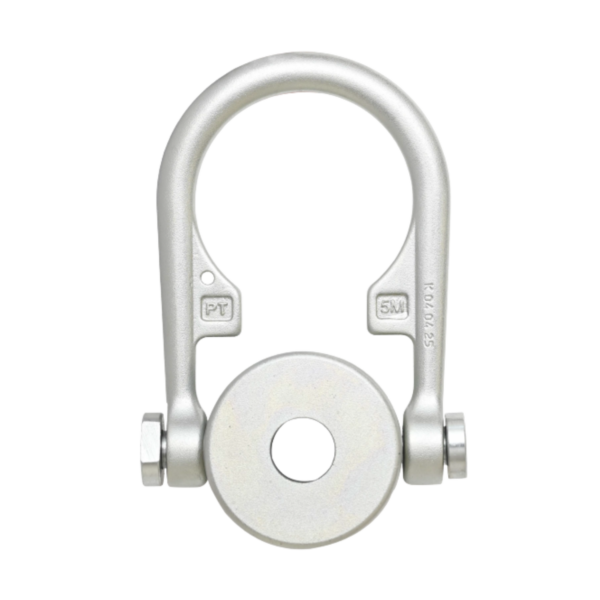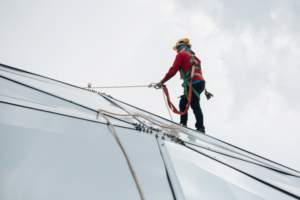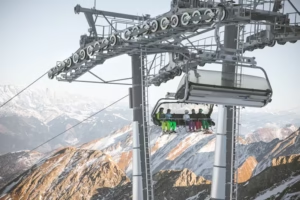Understanding What a Concrete 360 Degree Swivel Anchor Point Is
A Concrete 360 Degree Swivel Anchor Point is an essential safety device designed to provide a secure and flexible attachment for workers at height. It is a fall protection anchor system that allows a full 360-degree rotation, giving workers freedom of movement without compromising safety. Unlike fixed anchor points that limit mobility, swivel anchors reduce cable twisting and tangling during work. This makes them ideal for demanding environments such as construction sites, industrial plants, and maintenance projects. Built from heavy-duty steel, these anchors are embedded or bolted directly into concrete surfaces, ensuring high load-bearing capacity and durability. The rotating mechanism is engineered with precision bearings to maintain stability even under stress. By combining flexibility and strength, the Concrete 360 Degree Swivel Anchor Point represents a major advancement in modern fall protection systems.
Why Swivel Anchor Points Are Essential in Modern Construction and Safety Systems
Modern construction and industrial work demand reliable systems that adapt to dynamic movement and positioning. The Concrete 360 Degree Swivel Anchor Point fulfills this need by offering both safety and convenience. Its 360-degree rotation enables workers to reposition themselves without detaching from their lifeline, reducing risk. This flexibility is vital when performing tasks such as welding, painting, or cleaning at elevated areas. Beyond flexibility, swivel anchors also minimize wear and tear on connecting components by allowing cables to move naturally. They are compliant with major safety regulations like OSHA and ANSI, ensuring they meet strict fall arrest standards. The presence of a properly installed swivel anchor significantly decreases accident rates and enhances operational efficiency. With its combination of freedom, strength, and compliance, it has become an indispensable part of modern fall protection setups.
How Concrete 360 Degree Swivel Anchor Points Work
A Concrete 360 Degree Swivel Anchor Point operates on a simple yet effective mechanical principle. The anchor base is secured to a concrete surface, and its head is designed to rotate smoothly using high-grade ball bearings. This movement allows the worker to change direction seamlessly while keeping the connection stable and aligned. The load applied during use is evenly distributed through the anchor and the concrete structure, reducing stress concentration. This ensures long-term durability and prevents structural fatigue. Compared to single-axis anchors, which can only pivot in one direction, the full 360-degree design eliminates tangling issues and enhances range of motion. The result is a safer and more efficient working experience, especially in environments where movement around large or complex structures is necessary. This engineering innovation sets swivel anchors apart from traditional anchorage systems.
Key Benefits of Using Concrete 360 Degree Swivel Anchor Points
The advantages of using a Concrete 360 Degree Swivel Anchor Point go beyond just convenience. Its primary benefit is enhanced worker safety, as it provides consistent fall protection from multiple angles. The ability to rotate freely prevents cable binding, allowing users to move naturally without tension buildup. Another significant advantage is its long-lasting durability, made possible by corrosion-resistant coatings and premium materials like galvanized or stainless steel. This makes the anchor suitable for harsh conditions, from marine environments to dusty industrial sites. Additionally, these anchors reduce downtime and equipment wear, leading to cost savings over time.
Some of the key benefits include:
- 360-degree rotation that enhances mobility
- Heavy-duty materials designed for extended service life
- Compatibility with various safety harnesses and lanyards
- OSHA and ANSI compliance for guaranteed safety performance
- Reduced maintenance needs and improved reliability
Every benefit contributes to a safer, smoother, and more efficient workflow, making these anchors an invaluable investment for any safety-conscious operation.
Choosing the Right Concrete 360 Degree Swivel Anchor Point for Your Application
Selecting the proper Concrete 360 Degree Swivel Anchor Point involves understanding your specific work environment and safety needs. The first factor to consider is load capacity, which determines how much weight the anchor can safely support. Most anchors are rated between 5,000 to 10,000 pounds, depending on their design and material. It is also vital to assess the concrete surface, ensuring it has sufficient thickness and structural integrity for secure installation. Compatibility with your safety gear—such as harnesses, lanyards, and lifelines—must also be verified. Look for products that meet ANSI Z359 and OSHA 1926 regulations, as these ensure top-tier safety performance. Additionally, consider the type of work being done, as permanent anchors differ from temporary or portable options. By evaluating these aspects, you can select a swivel anchor that delivers both reliability and compliance for your project.
Proper Installation Techniques for Concrete 360 Degree Swivel Anchor Points
Installing a Concrete 360 Degree Swivel Anchor Point requires precision and adherence to safety guidelines. Begin by identifying a structurally sound area of concrete that meets the manufacturer’s thickness and strength requirements. Using a rotary hammer drill, create a hole at the specified diameter and depth for the anchor bolt. Insert the anchor, ensuring it sits flush against the surface, and tighten it with a torque wrench to the recommended specification. After installation, perform a pull test to verify that the anchor can handle the required load. Always follow the installation manual provided by the manufacturer to ensure compliance with OSHA and ANSI standards. Common mistakes to avoid include drilling into weak concrete, over-torquing bolts, or neglecting post-installation inspection. When done correctly, the anchor will provide a safe and dependable connection point for years.
Maintenance and Inspection Best Practices
Regular maintenance is crucial for ensuring the longevity and safety of Concrete 360 Degree Swivel Anchor Points. Inspection should be performed before every use and periodically according to the manufacturer’s schedule. Look for signs of corrosion, loose bolts, or any deformation in the anchor body. Keep the swivel mechanism clean and lubricated to maintain smooth rotation. During inspection, check that the anchor remains securely fastened to the concrete and that all moving parts function properly. Avoid using harsh chemicals that could damage protective coatings. It’s recommended to replace the anchor immediately if it shows any sign of compromise or after it has been subjected to a fall arrest event. Proper care and maintenance not only enhance safety but also extend the service life of the anchor system.
Common Applications of Concrete 360 Degree Swivel Anchor Points
The Concrete 360 Degree Swivel Anchor Point is versatile and suited for a wide range of work environments. It’s commonly used in construction sites where workers perform tasks at height. Roofers, painters, and window cleaners rely on it for stable support during movement. It is also used in industrial facilities, refineries, shipyards, and telecommunications towers. In maintenance operations, it provides a dependable anchor for technicians working on elevated structures. The swivel feature allows workers to maneuver around obstacles without repositioning their equipment. This adaptability makes it ideal for both permanent installations and temporary setups. Whether in vertical or horizontal anchorage systems, these anchors provide exceptional performance across various industries that demand both safety and mobility.
Safety Standards and Compliance Regulations
Compliance with safety regulations is a critical aspect of using a Concrete 360 Degree Swivel Anchor Point. OSHA 1910 and 1926 standards outline specific requirements for fall protection systems in construction and general industry. ANSI Z359 standards further detail testing procedures, material strength, and load capacity guidelines for anchors. Using certified anchor points not only protects workers but also minimizes liability for employers. Proper documentation and inspection logs are often required during safety audits. Non-compliant anchors can lead to fines or, worse, workplace accidents. Therefore, selecting equipment that meets or exceeds these regulations is essential. Adherence to these standards ensures that the anchor system is reliable, safe, and legally compliant, providing peace of mind for both users and safety managers.
Comparing Different Anchor Point Materials and Designs
Anchor points are made from different materials, each offering unique benefits depending on the environment. Stainless steel anchors are ideal for corrosion-prone areas, while galvanized steel provides a cost-effective balance of durability and protection. Some designs are intended for permanent installation, while others are removable or portable. The choice between concrete-mounted and beam-mounted swivel anchors depends on the worksite’s structure. Additionally, anchors can be rated for vertical, horizontal, or overhead loads, giving users flexibility in setup. Forged construction offers superior strength compared to cast models, ensuring better performance under heavy stress. Understanding these differences helps buyers select the right model that aligns with both safety requirements and environmental conditions.
Cost Factors and Return on Investment
The cost of a Concrete 360 Degree Swivel Anchor Point varies based on brand, material, and load capacity. While premium models might cost more initially, they deliver better performance and durability, reducing replacement frequency. Installation costs should also be considered, as proper setup ensures long-term reliability. Over time, investing in a high-quality anchor pays off by preventing accidents, lowering maintenance costs, and extending the lifespan of connected equipment. A well-maintained anchor system also enhances worker confidence and productivity. When evaluating cost, consider the total value—safety assurance, regulatory compliance, and reduced liability far outweigh the initial price.
Frequently Asked Questions (FAQ)
What is the maximum load capacity of a Concrete 360 Degree Swivel Anchor Point?
Most models support up to 5,000 pounds, though industrial variants can handle more depending on design.
Can these anchor points be reused after a fall event?
No. After a fall event, the anchor should be replaced immediately to ensure structural integrity.
How often should swivel anchor points be inspected?
Inspection should occur before each use and at least annually by a qualified safety professional.
Are they suitable for both temporary and permanent installations?
Yes, depending on the model. Some are designed for temporary use, while others can be permanently fixed to concrete.
What environmental factors affect performance and lifespan?
Humidity, salt exposure, and chemical contact can accelerate corrosion, so stainless or galvanized steel models are recommended for harsh environments.
Takeaway
The Concrete 360 Degree Swivel Anchor Point is more than a safety accessory—it’s a vital component that enhances protection, flexibility, and efficiency in any high-risk environment. Choosing the right anchor, installing it correctly, and maintaining it properly ensures the highest level of safety compliance and long-term performance. Investing in reliable swivel anchor systems means investing in worker safety, reduced operational risks, and overall productivity.






